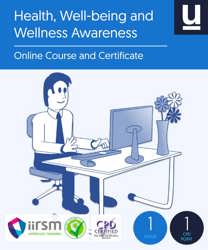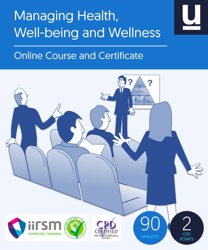What techniques improve mental health and wellbeing?
There are many ways to improve mental health. Incorporating healthy coping strategies and learning how to improve mental wellbeing overall can help you feel better and prepare you for life's problems.
Commodious is an Online Mental Health Training provider. We have compiled a list of simple and actionable techniques for improving mental health and increasing resilience to everyday stressors.
These techniques include:
- Cognitive Reframing
- Mindfulness
- Getting sufficient sleep
- Creating a support network
- Prioritising a healthy lifestyle
Keep reading to learn more about these strategies and how to incorporate them into your normal lifestyle.
What is Cognitive Reframing?
Cognitive Reframing helps shift your mindset from negative to positive. Adjusting our thoughts can help us have a more positive outlook and optimistic point of view.
To do this, try to recognise negative thoughts. Once you notice a thought pattern you want to adjust, you can replace or reframe your focus to more helpful thoughts.
Like trying anything new, this technique takes practice over time. Even though it takes time to learn this method, recognising destructive thought processes is important because it can help you see how your thoughts, feelings, and actions are connected. It can also keep you from getting stuck in a cycle of negative thoughts and harmful coping habits, leading to more bad thoughts.
The "catch it, check it, change it" method is one of the easiest ways to change your thoughts.
What is the "Catch it, check it, change it" technique?
The "catch it, check it, change it" method helps you learn how to change your thoughts and escape harmful mental loops.
Catch it: When you experience negative emotions, try to pinpoint what you are thinking at the time and what has caused these feelings.
Check it: An effective way to promote self-examination is writing down your thoughts and questioning whether there is any proof that they are true.
Change it: Then try to change these claims to more realistic ones.
For example, if you put yourself down because you didn't pass a test, you can be more objective and change "I'm not good at anything" to "I did my best, and this setback doesn't define me."
Trying this technique may initially feel uncomfortable, but regularly practising Cognitive Reframing will help shift thoughts toward positivity, supporting mental wellbeing.
What is Mindfulness?
Mindfulness has become a popular technique. It is the practice of intentionally noticing our thoughts, feelings, and surroundings in the present moment without judging them. Staying in the present lets us pinpoint negative thoughts and feelings early enough to change how we deal with them before we get too stressed.
Another aspect of mindfulness is paying attention to our surroundings. Noticing what we are doing, where we are doing it and how we are doing it helps identify reasons for positivity. Being present in the moment might expose us to positive opportunities we might not have seen before.
An easy way to adopt mindfulness is by practising breathing methods. You can try breathing techniques anywhere and at any time. Focusing on our breath can help us feel less stressed and more in the moment.
Check out our online mental health awareness course for more examples of mindfulness activities and information on how to practise them.
A simple breathing exercise
Try this simple breathing exercise:
Begin by settling into a comfortable position. Close your eyes and take a slow, deep breath in and out. As you do, relax your shoulders, and notice the sensations you feel as the breath enters and leaves the body.
While breathing, try to notice your body's physical sensations, like the feeling of your clothes or the chair underneath you.
Also, take the time to reflect on what you are thinking about and how you are feeling. Do not try to change these things - just be aware of your thoughts and how they affect one another.
When you feel ready, take another breath, and open your eyes. Try to take the awareness you felt during the exercise with you throughout the rest of your day.
Creating a sleep routine for mental wellbeing
When we sleep, our body and mind recharge. Getting enough sleep is essential for maintaining physical and mental wellbeing. Developing a routine to help you get the right amount of sleep works towards your overall health.
To create an environment to promote good sleep, try these tips:
- Go to bed and get up at the same time every night and every morning
- Limit screen-time before bed. These are a distraction and emit light that works against our body's sleep cues
- Incorporate a relaxing activity like reading or listening to calming music
- Avoid sugary and caffeinated foods and drinks before bedtime
- Keep your sleep space quiet, dark, and disturbance free if possible. Some find eye masks, blackout curtains, and earplugs helpful
Some sleep problems are severe and cannot be improved using the simple tips discussed here. If you have trouble sleeping after following these tips, seek medical advice.
How to develop a mental health support network?
Spending time with friends and family can help us to cope with stress, anxiety and depression. Socialising can contribute to feelings that improve mental wellbeing and build self-esteem. Talking to them about how you feel, whether online, by phone, or in person, can help improve your mental wellbeing. Some tips for developing better social contact are:
- Plan to spend time with friends and family regularly
- Try to connect with someone you trust every day
- Look for events or courses in your local area that interest you and where you can meet like-minded people
- Reach out to volunteers who can listen to you, such as Samaritans or CALM
- Try volunteering to help those in need
How does a healthy lifestyle help mental wellbeing?
Our mental and physical health are intrinsically linked. Improving physical health will aid mental wellbeing.
Physical exercise makes us feel better because it makes our bodies release endorphins, which make us feel less stressed and less pain. Even if you start small, you can still get these effects. For example, you could walk or do yoga daily and work up to more difficult activities over time.
Eat a healthy diet with lots of fruit and veggies. Sugary and fatty foods might give you a quick energy boost, but in the long run, they will tire you.
In Conclusion
Incorporating techniques to improve mental health and wellbeing is a proactive step towards leading a happier and more fulfilling life. Even small changes can have a big impact. Remember, mental health is a continuous journey, and these techniques require patience and consistency.
Embracing them can bring about positive changes, enhancing our mental wellbeing and overall quality of life.
To find out more about mental health and techniques for improving it, take our online mental health courses. These are available via the links below:







